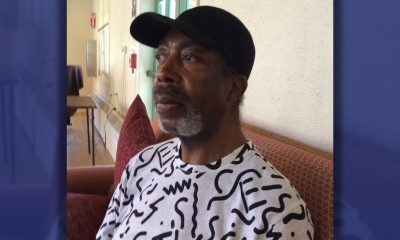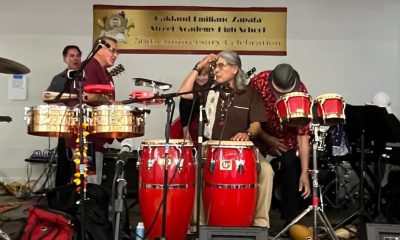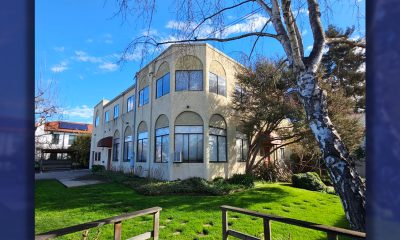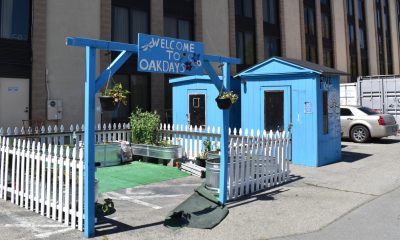Community
Hold Sheriff Accountable for Human Rights Violations at Alameda County Jail, Says New Report
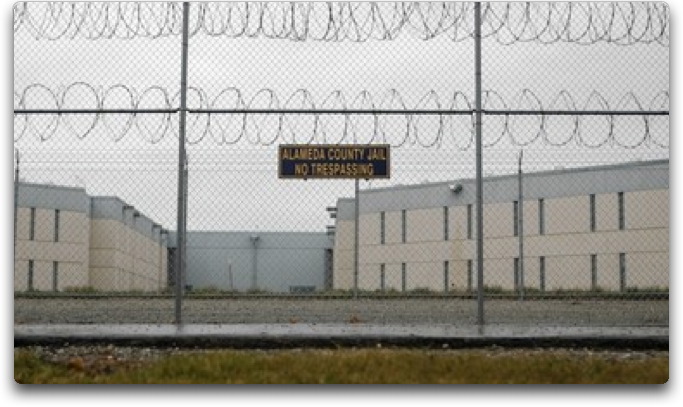
“Remember those who are in prison, as though you were in prison with them.” Hebrews 13:3
The Live Free Committee of Oakland Community Organization (OCO) released a report titled “What’s Up With Our Jails?” on Oct. 2, detailing human rights violations taking place in Alameda County jail.
The 2,600 people held in Alameda County jails daily are our brothers and sisters, fathers, mothers, and neighbors. The jails are ours, as taxpayers and voters, and should reflect our values.
Racial and economic injustices are evident in who ends up in jail. While we work to correct these injustices, our research raises urgent questions about county jail operations:
- Do our jails meet basic human rights standards?
- Do we offer persons leaving jail the resources they need to successfully return to our communities?
- What can we, as a community, do to make a difference?
Who Runs Our Jails?
The Alameda County Sheriff is the elected official with authority over county jail operations. The Alameda County Sheriff’s Office (ACSO), under the direction of Sheriff Gregory Ahern since 2006, also polices unincorporated areas of the county and functions as county coroner.

Alameda County Sheriff Greg Ahern. Photo by Shane Bond.
The Alameda County Board of Supervisors, also an elected body, is responsible for authorizing the annual ACSO budget and monitoring jail conditions.
Who Is Locked Up?
Alameda County has two jails — the Santa Rita Jail (the larger facility, in Dublin) and the Glenn E. Dyer Detention Facility (a high-rise maximum security jail in Oakland).
In early 2018, the county jails held on average 2,362 men and 236 women daily. The average daily jail population is more than 50 percent African-American, 20 percent Latino, and less than 20 percent white.
Reasons for Incarceration: Only 446 (18 percent) of the 2,598 people held in our jails in early 2018 were actually serving sentences. According to ACSO data from December 2017, of those detained but not sentenced, one-third were bail-eligible.
They remained in custody because they were too poor to afford bail.
Length of Incarceration: Some people are serving sentences of years rather than months in our jails. State prison reforms in 2011 moved many people convicted of nonviolent crimes from state jurisdiction to the counties.
For lower-level offenders, local supervision is supposed to be better than state prison. Yet county jails were never intended for long confinement.
Even pretrial incarceration can take years. In 2013, for instance, Dajon Ford was arrested as a juvenile and spent four years in Santa Rita awaiting trial before community efforts finally won his freedom.
OCO Findings
OCO leaders have heard many complaints about the treatment of people detained in the county’s jails over the years. Based on our research, we find these to be the most serious current problems.
Pregnancy: At Santa Rita, pregnant women are in with the general population unless they ask to be moved to a medical unit, which means isolation 23 hours a day. Multiple sworn testimonies reveal that medical needs for pregnant women are often neglected.
“A very pregnant woman … was in so much pain she could not walk. … Instead of taking her to receive medical care, [deputies] placed her in an isolation cell … [she] began to scream. This went on for hours. … Finally, we could hear the crying of a baby … [she] had given birth, alone,” from a sworn declaration of a woman incarcerated at Santa Rita.
Medical Care: Many lawsuits have been brought against the jails’ for-profit medical care contractors. Sheriff’s deputies are not trained as certified emergency medical responders. In 2015, Mario Martinez died in Santa Rita when deputies ignored cries for help and failed to provide needed medical care.
Food Services: Complaints about poor jail food and kitchen cleanliness — including reports of animal feces and rats — are common. A recent Alameda County Public Health Department inspection found that 24 percent of persons in Santa Rita were not getting their required diets. Canteen food is available, but only to those who can pay for it.
Hygiene Services: Female inmates have testified in recent lawsuits that they cannot get the sanitary supplies they need. During the 2017 hunger strike at Glenn Dyer, inmates complained that they were getting only one set of clean clothes per week.
Isolation: Ten percent of Santa Rita inmates and 20 percent of Glenn Dyer inmates are held in “administrative isolation” — a kind of solitary confinement. Isolation was a major grievance of the Glenn Dyer strikers. Studies have shown solitary confinement can “severely impair prisoners’ capacity for normal human functioning.”
Contact with Family and Community: Family visitation is restricted to 30 minutes. No physical contact is permitted. Visiting hours are available during limited hours, three days a week. The cost of phone and video calls runs about $6 for 15 minutes.
“It kills me mentally to be in jail,” said a young man who was held in Santa Rita.
“A 30-minute visit maximum a week … is not enough. It breaks families. They use visits as punishment, taking visits away,” said two men formerly held in Santa Rita.
Lack of Translators: Although there are bilingual deputies and ACSO has a rulebook in Spanish, there are no dedicated translators on staff. Translation is often done informally among inmates. Language barriers can prevent individuals from participating in programs and services.
ICE and Undocumented Persons: Despite sanctuary policies passed by the Board of Supervisors that restrict contact between ICE and law enforcement, the Sheriff’s Office has posted inmates’ release dates on the internet. This allows ICE to take undocumented persons into custody (even though being held at Santa Rita Jail is not evidence of criminal guilt) and exposes others to harassment or retaliation as they leave the jail.
Release from Jail: People are often released from our jails at night and alone with no more than a BART ticket — without even a few days’ supply of essential medications. Since Medi-Cal benefits are automatically suspended in jail, many people return to the community with no medical coverage.
“They just release you. No referrals. They gave me a $5 BART ticket. I had to walk to the BART station in my [jail] blues,” according to two young men released from Santa Rita.
Re-entry and Rehab Programs: In 2014, the Alameda County Board of Supervisors adopted a re-entry strategic plan to help break the cycle of returning the same people to jail.
The plan, not yet implemented, acknowledges the need to provide inmates with a wide range of services such as housing, health care, mental health and substance abuse services; employment; and education.
Yet rehabilitative programs within Santa Rita Jail remain underfunded and understaffed, serving relatively few inmates effectively. Only the most motivated individuals tend to get the help they need. But society would be better off if everyone received needed services.
They classify people by tattoos, gang, where they’re from. … Couldn’t take college or trade classes in there because of security,” said one young man who had been in Santa Rita.
“There are waiting lists. Everybody is trying to get into a program,” said another young man who did time in the jail.
Our sources report that ACSO’s jail classification system (the way it segregates and houses people for security and other reasons) ends up denying program access to those who need resources the most. (ACSO, unlike state prisons, does not make its classification system public.)
ACSO also routinely excludes formerly incarcerated persons from serving as community program staff and peer mentors within the jail, eliminating another invaluable resource for inmates.
We must reduce the likelihood of people returning to jail. The community has a right to expect that people returning to our families and neighborhoods after staying in our jails will not be worse off than before they were detained.
Community Action Makes a Difference
- Demand that our jails adopt best practices – changes Alameda County should initiate immediately:
- Adopt the higher California state prison standards for conditions of confinement, which reflect the needs of inmates held for longer periods.
- Adopt a supportive model for meeting the critical needs of pregnant women and new mothers.
- Make the cost of phone calls and jail canteen food affordable for all inmates, as Santa Clara County has done.
- Prohibit the posting of inmate release information on the internet where it can endanger the lives and safety of those departing custody.
- Insist on more effective community re-entry programs.
- Return to the community is the expected outcome for every person held in our jails. This understanding should drive a comprehensive “needs-based” re-entry plan for each individual. As the re-entry strategic plan adopted by the county in 2014 stated, effective re-entry “begins with assisting the individual at the earliest possible point of contact with the criminal justice system [and continues] through community-based supervision and community integration.”
- Require A Full Needs Assessment: Every inmate must receive a full assessment of their needs so that they are better prepared to re-enter the community. This means identifying their health, education, housing, and employment needs. Job training and placement are particularly essential to successful re-entry.
- Release with a Warm Hand-Off: Our jails must ensure that all released individuals have safe transportation, emergency housing if needed and access to critical community services to meet their immediate needs (medical services, mental health care, substance abuse treatment and domestic violence prevention).
Four hours after her 1:30 a.m. release from Santa Rita on July 28, 2018, Jessica St. Louis, 26, was found dead near the passenger pick-up area of the Dublin/Pleasanton BART station, two miles from the jail, according to the San Francisco Chronicle, Aug. 8, 2018.
The county must ensure that Medi-Cal benefits are reinstated at the point of release. San Diego and Los Angeles counties work with the Department of Motor Vehicles so that everyone leaving jail has an ID or driver’s license. Alameda County should adopt this model.
- Ensure Continuity with Community-Based Providers: On-site and re-entry programs are better run by community-based providers who can offer continuity of services once people are released, rather than by the Sheriff’s Office whose primary expertise is detention and law enforcement.
In its re-entry strategic plan, the Board of Supervisors concurred that a successful return to the community relies on “high-quality, peer-involved and comprehensive” programs and services.
- Hold our elected officials accountable and institute community oversight.
The Alameda County Board of Supervisors holds the purse strings of the Sheriff’s Office. Since 2005, the county jail population has declined by 45 percent while the sheriff’s budget for detention and corrections has increased by 92 percent. This large increase in ACSO’s resources raises questions for taxpayers:
How are these dollars being used?
How can money be reinvested in community-based re-entry programs and services?
- Conduct a financial management and performance audit: The Justice Reinvestment Coalition (a community group that includes OCO) has proposed a Financial Management and Performance Audit to determine how ACSO has used increased resources while its jail population has decreased — and to what effect. The audit is an essential step toward systematic ACSO transparency. We demand that the Board of Supervisors adopt the audit as proposed.
- Separate coroner duties from the sheriff: In Alameda County, the sheriff is also the county coroner by law. Deaths that occur inside the jails are medically examined by ACSO (including two deaths that occurred within one week in June 2018). Coroner duties must be separated from the Sheriff’s Office.
- Establish independent oversight: No one can be expected to monitor their own behavior objectively. Los Angeles and Santa Clara counties have initiated independent oversight agencies of their sheriff’s departments. Alameda County should adopt a model of independent community oversight of jail conditions and re-entry programs.
Greater accountability and oversight of the Sheriff’s Office are in the interests of a wide range of stakeholders in Alameda County, including deputies working in the jails.
What’s Next?
The immediate goals of OCO’s Live Free Committee are to guarantee humane jail conditions and to return individuals to the community with the resources to improve their chances for success.
For information about OCO’s jail project as well as sources, methods, citations and notes, see www.oaklandcommunity.org/OurJails or contact BK Woodson Sr. at servantbk@
oaklandcommunity.org
Activism
Oakland Post: Week of May 8 – 14, 2024
The printed Weekly Edition of the Oakland Post: Week of May May 8 – 14, 2024

To enlarge your view of this issue, use the slider, magnifying glass icon or full page icon in the lower right corner of the browser window. ![]()
Activism
S.F. Black Leaders Rally to Protest, Discuss ‘Epidemic’ of Racial Slurs Against Black Students in SF Public School System
Parents at the meeting spoke of their children as no longer feeling safe in school because of bullying and discrimination. Parents also said that reported incidents such as racial slurs and intimidation are not dealt with to their satisfaction and feel ignored.

By Carla Thomas
San Francisco’s Third Baptist Church hosted a rally and meeting Sunday to discuss hatred toward African American students of the San Francisco Unified School District (SFUSD).
Rev. Amos C. Brown, president of the San Francisco NAACP and pastor of Third Baptist Church, along with leadership from local civil rights groups, the city’s faith-based community and Black community leadership convened at the church.
“There has been an epidemic of racial slurs and mistreatment of Black children in our public schools in the city,” said Brown. “This will not be tolerated.”
According to civil rights advocate Mattie Scott, students from elementary to high school have reported an extraordinary amount of racial slurs directed at them.
“There is a surge of overt racism in the schools, and our children should not be subjected to this,” said Scott. “Students are in school to learn, develop, and grow, not be hated on,” said Scott. “The parents of the children feel they have not received the support necessary to protect their children.”
Attendees were briefed last Friday in a meeting with SFUSD Superintendent Dr. Matt Wayne.
SFUSD states that their policies protect children and they are not at liberty to publicly discuss the issues to protect the children’s privacy.
Parents at the meeting spoke of their children as no longer feeling safe in school because of bullying and discrimination. Parents also said that reported incidents such as racial slurs and intimidation are not dealt with to their satisfaction and feel ignored.
Some parents said they have removed their students from school while other parents and community leaders called on the removal of the SFUSD superintendent, the firing of certain school principals and the need for more supportive school board members.
Community advocates discussed boycotting the schools and creating Freedom Schools led by Black leaders and educators, reassuring parents that their child’s wellbeing and education are the highest priority and youth are not to be disrupted by racism or policies that don’t support them.
Virginia Marshall, chair of the San Francisco NAACP’s education committee, offered encouragement to the parents and students in attendance while also announcing an upcoming May 14 school board meeting to demand accountability over their mistreatment.
“I’m urging anyone that cares about our students to pack the May 14 school board meeting,” said Marshall.
This resource was supported in whole or in part by funding provided by the State of California, administered by the California State Library via California Black Media as part of the Stop the Hate Program. The program is supported by partnership with California Department of Social Services and the California Commission on Asian and Pacific Islander American Affairs as part of the Stop the Hate program. To report a hate incident or hate crime and get support, go to CA vs Hate.
Bay Area
Mayor London Breed: State Awards San Francisco Over $37M for Affordable Housing
On April 30, Mayor London N. Breed announced San Francisco has been awarded more than $37.9 million in funding from the California Department of Housing and Community Development (HCD) as part of the State’s Multifamily Housing Program (MHP). The HCD loan will provide the final funding necessary for development of Casa Adelante – 1515 South Van Ness, a 168-unit affordable housing project located in San Francisco’s Mission District.

By Oakland Post Staff
On April 30, Mayor London N. Breed announced San Francisco has been awarded more than $37.9 million in funding from the California Department of Housing and Community Development (HCD) as part of the State’s Multifamily Housing Program (MHP).
The HCD loan will provide the final funding necessary for development of Casa Adelante – 1515 South Van Ness, a 168-unit affordable housing project located in San Francisco’s Mission District.
The new development at 1515 South Van Ness Ave. will provide 168 affordable homes to low-income families, formerly homeless families, and persons living with HIV earning between 25-80% of the San Francisco Area Median Income (AMI).
In addition, the project is anticipated to provide family-friendly amenities and ground floor community-serving commercial spaces that preserve the prevailing neighborhood character of the Calle 24 Latino Cultural District.
“This funding unlocks our ability to move on building affordable housing units for families in San Francisco at a crucial time. We understand the level of need for more housing that is accessible, and like the state, the city continues to face a challenging budget cycle,” said Breed. “1515 South Van Ness is a good example of what can be achieved in San Francisco when you have strong community partnerships and an unwavering commitment to deliver on critical needs for our residents.”
“From the beginning of my term as Supervisor, I have fought to bring affordable housing to 1515 South Van Ness” said Supervisor Hillary Ronen. “In the interim, the site has been utilized for homeless services and shelter, and I am thrilled that HCD has recognized the value of this development, and we are finally ready to break ground and bring 168 affordable homes to low income and formerly homeless families in the Mission.”
Owned and occupied by McMillan Electric Company until 2015, the City and County of San Francisco purchased 1515 South Van Ness Avenue in June 2019 with the intent of developing new affordable housing.
In November 2020, the San Francisco Mayor’s Office of Housing and Community Development (MOHCD) released a Multi-site Request for Qualifications (RFQ) seeking qualified developers to build affordable housing on the site, and subsequently selected Chinatown Community Development Corporation (CCDC) and Mission Economic Development Agency (MEDA) in May 2021 to develop the site.
The project is expected to begin construction in winter 2025.
“A strong, long-term push by Mission advocates to make this site 100% affordable is now paying off, with 168 family units that include services and childcare. People of color communities know what they need, and we are excited to be in partnership with a team, consisting of MEDA, CCDC, and MOHCD, that listens,” said Malcolm Yeung, Executive Director at CCDC.
“We are excited to be in partnership with CCDC, yet again, and for the opportunity to develop intergenerational affordable housing in the City’s Mission District,” said Luis Granados, executive director at MEDA.
Increasing housing affordable to lower-income and vulnerable residents is a key priority in the City’s Housing Element which calls for additional funding for affordable housing production and preservation, as well as Mayor Breed’s Housing for All Executive Directive that sets out the steps the City will take to meet the bold goal of allowing for 82,000 new homes to be built over the next eight years.
Tuesday’s funding announcement emphasizes the importance of regional and state collaboration in order to reach our housing and climate goals.
“We are thrilled—not just to bring a project of this size to a community with great need — but to do so with community-based developers and their partners who understand the neighborhood and sensitivities around cultural preservation,” said HCD Director Gustavo Velasquez.
-

 Community3 weeks ago
Community3 weeks agoFinancial Assistance Bill for Descendants of Enslaved Persons to Help Them Purchase, Own, or Maintain a Home
-

 City Government6 days ago
City Government6 days agoCourt Throws Out Law That Allowed Californians to Build Duplexes, Triplexes and RDUs on Their Properties
-

 Activism2 weeks ago
Activism2 weeks agoOakland Post: Week of April 24 – 30, 2024
-

 Business3 weeks ago
Business3 weeks agoV.P. Kamala Harris: Americans With Criminal Records Will Soon Be Eligible for SBA Loans
-

 Activism4 weeks ago
Activism4 weeks agoOakland Post: Week of April 10 – 16, 2024
-

 Community3 weeks ago
Community3 weeks agoAG Bonta Says Oakland School Leaders Should Comply with State Laws to Avoid ‘Disparate Harm’ When Closing or Merging Schools
-

 Community3 weeks ago
Community3 weeks agoRichmond Nonprofit Helps Ex-Felons Get Back on Their Feet
-

 Community3 weeks ago
Community3 weeks agoOakland WNBA Player to be Inducted Into Hall of Fame


